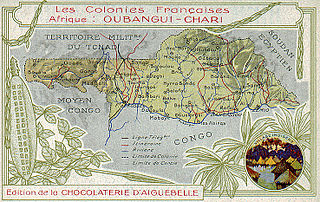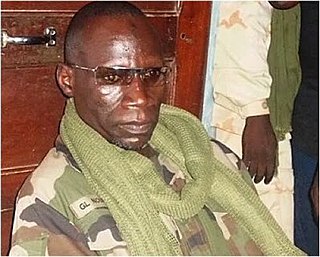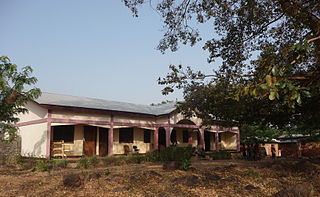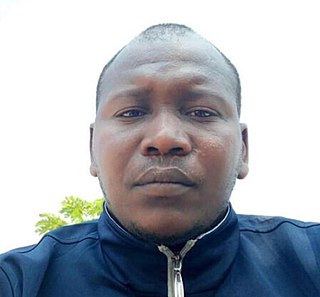History
Bakouma was founded in September 1892 when the Belgians, led by Commander Georges Adolphe Balat and Captain Georges Le Marinel set up a military post on the site. It became a part of the French Upper Oubangui in July 1894. Bakouma became a district under the French rule in 1944 and on 23 January 1961, the region eventually became a Sous-Préfecture in the Mbomou prefecture in the newly formed Central African Republic. . [1]
The Lengo Petroglyphs are located near Bakouma.
In a uranium survey in 1959–1961, phosphatic sediments were discovered near Bakouma. The phosphates are characterized by their high uranium content, which are the highest in sub-Saharan Africa. [2] Further feasibility studies showed that in the area, there are 41 million pounds of U3O8 with an average grade of 0.27% (which is almost 20 times higher than the resources in Trekkopje, Namibia). [3] A large concentration of Cretaceous ferruginous limestones has also been found near Bakouma. .
However, commercial exploitation in the area never took off. The French Commissariat à l'énergie atomique (CEA) studied the area, as did Alusuisse in the 1970s, which only came to conduct small scale mining. The Japanese in the 1980s came to the conclusion that any large exploitation would not be commercially viable.
During the 1990s, former political prisoner Jeanne-Marie Ruth-Rolland was elected deputy leader of Bakouma and lead a gold prospector's consortium. She was also active in diamond mining in the area. Following her death, a monument was elected in her honor.
Due to the increasing world market price on uranium, combined with decreasing stocks, the area gained new interest in the mid-2000s. Australian company Paladin Energy expressed its interest in the area, but it never took off. The same thing happened with the Chinese.
Finally, in May 2006, the South African company UraMin invested 90% in a Bakouma uranium project. The remaining 10% is held by the Government. A mining convention was signed, guaranteeing fixed taxes for 25 years. The project consists of ten separate areas of uranium mineralization and the consortium has applied for two additional licenses, which, if granted, would extend the project area to 2,900 square kilometres. A feasibility study that started in August 2006 has drilled some 9,400 meters and indicated that the resource is significantly deeper than previous studies have shown. The production is expected to ramp up from late 2009 and peak in 2010 at 3000 tonnes Per Annum. [3]
Civil war
In July 2017 it was reported that Bakouma was under joint control of anti-balaka and FPRC rebel groups. [4] From December 2018 to January 2019 heavy clashes took place in the city between ex-Séléka militias and government forces resulting in withdrawal of ex-Séléka militias.
Three UN peacekeepers from Burundi were killed in Dekoa and Bakouma on 26 December 2020, one day before the 2020 Central African general election. [5] On 29 December government forces withdrew from Bakouma after being surrounded by FPRC and UPC rebels. [6] On 10 May 2021 Bakouma was recaptured by government forces. [7]
Geography and climate
Bakouma is situated on the Gboyo River. In is on the northern end of the Mbomou forest, which has an area of 10.000 km2.
When it became clear that the Government was going to allow for a concession of uranium, many voices were heard, mainly from the opposition, claiming that uranium mining in other countries has created much harm to the environment and the population. The Government claimed that this was the words of evil tongues. It said that the bill on the regulation of exploitation of radioactive minerals, which passed the Parliament on 30 August 2006, would protect from any such damage.
UraMin has started to drain the marches on its site.
Law and government
Although the Government has its representative in Bakouma, the presence of UraMin in the town has attracted visits of several high-level government officials. When UraMin arrived with their first equipment to Bangui, the unloading of the airplane was monitored by the Minister of Mining and Energy, Sylvain Ndoutingaï. When the team later arrived in Bangassou with a second plane, the unloading was monitored by the prefect of Mboumou, Remy Sem Ndouto, along with representatives of the police, the gendarmerie, the customs and the armed forces. The customs was represented by Colonel Yvon Songue. [8]
In March 2007, the UraMin site was inspected by the Director for the Ministry of Mining and Energy, Mr Guy Ngaïkomessé. Also present were the Regional Director for Mining, the Assistant Commander of the Mining Brigade, the Commander of the Mboumou Police Force as well as several police and gendarme officers. They found that the UraMin team consisted of six Tanzanians, two Europeans and one Cameroonian. The Tanzanians and the Cameroonian did not have visas for the country and were brought to Bangui for regularisation. [9]
Economy
3000 people are expected to be employed by UraMin and the Government has predicted a boom for the whole region. [8] Numerous young men have left Bangassou, Nzako, Irabanda in Haute-Kotto for Bakouma. However, there has been reports that members of the Central African Government has arranged for transport of their own family members and own ethnic groups to Bakouma, to function as manpower in the mining project. This has led to irritation among Bakouma's original citizens. [10]
Prices on food items are said to have exploded since the international mining companies arrived. While the normal price on chicken is said to be 600 or 700 CFA franc, it is now negotiated at between 1500 and 2000 CFA franc. Fish and beef can hardly be found at all. [11]
There is a small hydro-power plant on the left bank of Gboyo, which is owned by the Catholic Diocese of Bangassou. The water flows of the river allows electricity production 305 days per year. The electricity is used to feed the mission and its hospital.
Transport
Bakouma is located about 870 km from Bangui. UraMin, which has its site 7 km outside of Bakouma has invested 0.5 million to upgrade road access, but it is unknown what other roads in the area will be upgraded. The Catholic Diocese of Bangassou has recently upgraded 19 bridges between Bakouma and Nzako.
There is an airstrip in Bakouma, close to the uranium exploitation. But when UraMin arrived with its machinery in July 2006, the Antonov freighter had to land at Bangassou, [8] with a considerably longer runway.

The history of the Central African Republic is roughly composed of four distinct periods. The earliest period of settlement began around 10,000 years ago when nomadic people first began to settle, farm and fish in the region. The next period began around 10,000 years prior.

The politics of the Central African Republic formally take place in a framework of a semi-presidential republic. In this system, the President is the head of state, with a Prime Minister as head of government. Executive power is exercised by the government. Legislative power is vested in both the government and parliament.

Bria is the capital of Haute-Kotto, one of the 14 prefectures of the Central African Republic. As of the 2003 census the town had a population of 35,204.

Bangassou is a city in the south eastern Central African Republic, lying on the north bank of the Mbomou River. It has a population of 24,447 and is the capital of the Mbomou prefecture. It is known for its wildlife, market, and nearby Bangassou Airport and is linked by ferry to the Democratic Republic of Congo on the south bank. The city is also home to the Roman Catholic Diocese of Bangassou.
Ippy is a town located in the Central African Republic prefecture of Ouaka, and is located near the geographic center of the country. It is 364 kilometers from the city of Bangui directly. Driving distance, however, is 496 kilometers.

The Central African Republic's mineral resource endowment includes copper, diamond, gold, graphite, ilmenite, iron ore, kaolin, kyanite, lignite, limestone, manganese, monazite, quartz, rutile, salt, tin, and uranium. Of these commodities, only diamond and gold were produced in 2006 - subsistence farming was the mainstay of the economy.

The Central African Republic Civil War is an ongoing civil war in the Central African Republic (CAR) involving the government, rebels from the Séléka coalition, and Anti-balaka militias.

Séléka CPSK-CPJP-UFDR was an alliance of rebel militia groups that subjugated the Central African Republic (CAR) on 24 March 2013. After its official dissolution in September 2013, the remaining rebel groups became known as Ex-Séléka. Séléka leader Michel Djotodia became the nation's president from March 2013 until his resignation in January 2014. Members of Séléka were almost all Muslim.

An internal conflict in the Central African Republic (CAR) started essentially on 13 April 2013, when the government of President Michel Djotodia officially took over. The fighting was between the government of the Central African Republic's former Séléka coalition of rebel groups, who are mainly from the Muslim minority, and the mainly Christian anti-balaka coalition. The conflict was part of the ongoing Central African Republic Civil War (2012–present). International organisations, such as the United Nations, had warned of a possible genocide. UNSC resolution 2122 authorised the African-led International Support Mission to the Central African Republic (MISCA) to be deployed to the country, and France to lead operations with additional troops sent to bolster its force in the country. Following a summit of Economic Community of Central African States (CEEAC), including the attendance of all the country's MPs, Djotodia resigned from the presidency on 10 January 2014. The National Transitional Council chose Bangui mayor Catherine Samba-Panza as interim president on 20 January 2014. A period of lawlessness prevailed during the early days of her presidency with people moving into religiously cleansed neighbourhoods as the UN warned of a genocide. Anti-Balaka attacks continued against Muslim civilians.

Noureddine Adam is the leader of the Central African rebel group, the Popular Front for the Rebirth of Central African Republic (FPRC) in the Central African Republic Civil War.
The following is a timeline of events during the Central African Republic Civil War.

Popular Front for the Rebirth of Central African Republic is a rebel group in the Central African Republic which controls areas of the northern part of the country, until 2021 based in N'Délé.

General elections were held in the Central African Republic on 27 December 2020 to elect the President and National Assembly. A second round of the legislative elections was originally scheduled to take place on 14 February 2021.
The Coalition of Patriots for Change (CPC) is a coalition of major rebel groups in the Central African Republic created in 2020 to disrupt the 2020–21 Central African general election.

Nzacko or Nzako is a village located in the Central African Republic prefecture of Mbomou on the road between Bakouma and Bria.
Sam Ouandja is a town located in the Central African Republic prefecture of Haute-Kotto near the border with Sudan. It has historically served as important arms trafficking hub for armed groups in Central African Republic. Artisanal diamond mining is also active in the commune.
Haroun Gaye is a Central African warlord, general in the Popular Front for the Rebirth of Central African Republic (FPRC), sanctioned by international institutions.

Mahamat Saleh Adoum Kette is a Central African warlord, general in the Popular Front for the Rebirth of Central African Republic (FPRC). He is responsible for multiple war crimes including murder, rape, forced marriage, torture and looting.
Mahamat Said Abdel Kani was a former general of FPRC and commander of Seleka who was arrested in 2021 for war crimes. He is the first Seleka commander to face charges at the ICC.












